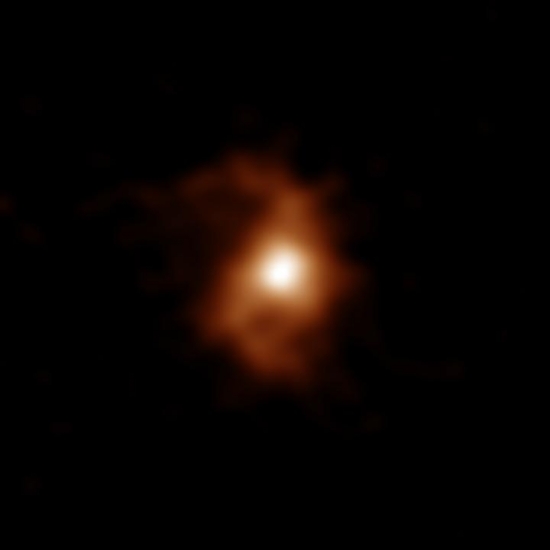My fascination with the earliest era of star and galaxy formation leads me to a new paper on an intriguing find. The authors describe the distant object BRI 1335-0417 as “an intensely star-forming galaxy,” and its image as captured by the Atacama Large Millimeter/submillimeter Array (ALMA) is striking. This is a galaxy that formed a mere 1.4 billion years after the Big Bang, making it the most ancient galaxy with spiral structure ever observed.
Spirals make up perhaps 70 percent of the galaxies in our catalogs, but how they form is an open question. Indeed, the proportion of spiral galaxies declines the further back in the evolution of the universe we observe. The spiral structure observed here extends 15,000 light years from the center of the galaxy (about a third the size of the Milky Way), while the total mass of stars and interstellar matter roughly equals our own galaxy.

Image: ALMA image of a galaxy BRI1335-0417 in the Universe 12.4 billion years ago. ALMA detected emissions from carbon ions in the galaxy. There is a compact and bright area in the center of the galaxy, and spiral arms are visible on both sides of it. Credit: ALMA (ESO/NAOJ/NRAO), T. Tsukui & S. Iguchi.
The BRI1335-0417 observations were performed by Satoru Iguchi (SOKENDAI/National Astronomical Observatory of Japan), working with graduate student Takafumi Tsukui, who is lead author of the paper reporting the work. Huge amounts of dust exist here, obscuring the object in visible light, but ALMA’s prowess at detecting radio emissions from carbon ions makes the investigation possible.
Even so, Tsukui points out that getting the size of the galaxy right is a difficult matter:
“As BRI 1335-0417 is a very distant object, we might not be able to see the true edge of the galaxy in this observation. For a galaxy that existed in the early Universe, BRI 1335-0417 was a giant.”
The biggest issue is how such a large structure with obvious spiral structure emerged so soon after the Big Bang. This is a ‘starburst’ galaxy: There are areas of active star formation here and gas instabilities in the outer parts of the disk which point to possible interactions with smaller galaxies or other interstellar matter. The paper points out that dusty galaxies with high rates of star formation, like BRI 1335-0417, are the progenitors of elliptical galaxies, with the spiral structure possibly redistributing angular momentum so as to trigger gas inflows into the center of the galaxy.
The authors are quick to note, however, that gas inflows like this are beyond the detection threshold of these observations. What we do see is the possibility of tidal interactions. The authors describe the likelihood of such events:
The high star formation rates of z > 4 [the measure of redshift] galaxies like BRI 1335-0417 are commonly explained as the result of major mergers, which could produce distorted galactic kinematics. We find that BRI 1335-0417 has only slightly disturbed, rotation dominated kinematics, which can be well described by a rotating disk model. This suggests that the high star formation rate must have been maintained long enough for the disk to form after any major merger event. The Q parameter [a measure of stability in a rotating, gaseous accretion disc] shows the outer disk of BRI 1335-0417 is unstable, which could be caused by gas accretion along large-scale filaments of the cosmic web, and/or minor mergers with accreting satellites.
So we have spiral structure, a rotating galactic disk, and a centralized mass. Is BRI 1335-0417 the ancestor of a giant elliptical galaxy? Answering that question of galactic survival and change involves issues of galaxy evolution that remain wide open.
The paper is Tsukui & Iguchi “Spiral morphology in an intensely star-forming disk galaxy more than 12 billion years ago,” published online in Science 20 May 2021 (abstract).



I don’t think BRI 1335–0417 is the ancestor of an elliptical galaxy. It’s the reverse. It is after affects of a collision of two spiral galaxies which will become an elliptical galaxy which are formed by two spiral galaxies colliding and then combining which would explain the star formation.
How do we know its a spiral galaxy? I concede the image suggests spiral structure, but perhaps the morphology is more irregular or peculiar, and the “arms” are just an anomaly, a statistical outlier, or even a coincidence.
My guess is this is just an artifact of an interaction between galaxies, or some unusual and rare turbulent event or condition that may have been more common in the early universe.
A blurry image by itself is not enough to suggest a Grand Design Spiral, unless corroborated with other observations and details; and hopefully, multiple observations of similar phenomena. The human mind and eye is very good at seeing patterns… even patterns that may not actually exist.
Thinking about this more carefully, BRI 1335–0417 could be the ancestor of the elliptical galaxy which generally assumed to be the final stage of a galaxy. If it looks like is has a spiral, it most likely is a spiral. Maybe the JWST can resolve it and tell us more about it.